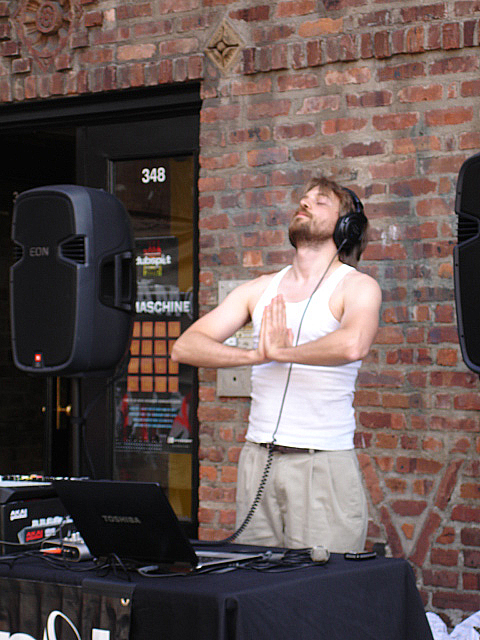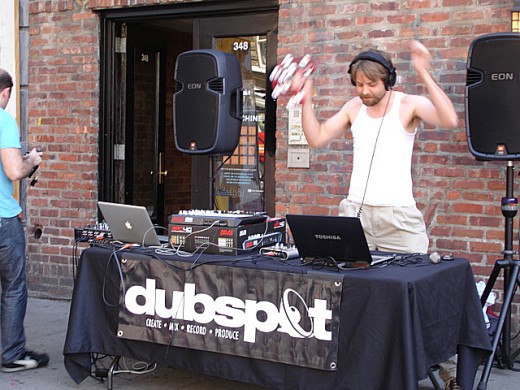 Photo & story by Luisa Caldwell
Photo & story by Luisa Caldwell
Williamsburg resident John Englemann, whose stage name is a mythical date—”March Thirty Seventh”—played Electronica music in the Dubspot line-up in the Meat packing District this past week during the Make Music NY events. I went to watch him perform and also enjoyed several other Make Music locations on the way. It was a hot beautiful summer afternoon, his computerized sounds livened up with tambourine and vocals of strange sounds, and even dramatic body work made me want to dance, and also to find out a little more…
I asked John about his music on the computer:
You play actual instruments like the guitar—so what draws you to Electronica?
I find most Electronica to be aesthetically richer than instrument-based music. Also, I’ve never been a lyric-oriented person, so it’s more of a fit to create music that is mostly devoid of words. Growing up, I listened more to the accompaniment than to the lyrics when the radio was on, and I was drawn to synthesized instrumentals like “Axle F” and the Miami Vice theme song. My German roots may contribute as well, because I am very detail-oriented with music and like to control every aspect of it.
How does it compare to playing an instrument—after all you are still making music?
Most music-making computer applications have virtual buttons and knobs to trigger and modify sounds in real-time, as well as a “virtual piano.” However, I don’t like to use any of these features unless I have to. I tend to use the computer as a player piano with a piano rolls that I punch holes in. I treat playing “real” instruments as a completely different aspect of music. While I enjoy playing the guitar, I don’t write music for the guitar, because I would be limited to the notes, chords, melodies, and so on, which I’m physically able play.
How is it done, do you create all the sounds, or are some pre-programmed?
I create as many of the sounds as possible. I never use prefabricated sound loops, templates, or default software settings. Every note is either clicked into place by the mouse or randomly generated according to parameters that I have chosen. I do use some “cheesy” samples from 1980s drum machines and keyboards, but I prefer non-mainstream sources: speech from my family’s old answering machine, a snare drum from a friend’s demo recording, home-recorded cassettes purchased at thrift stores, etc. Also, there are samples that I created from scratch that are intended to mimic well-known sounds; I could just use the “real” sample, but somehow it’s much more satisfying to do things the hard way.
For more info go to http://www.myspace.com/marchthirtyseventh
Leave a Reply